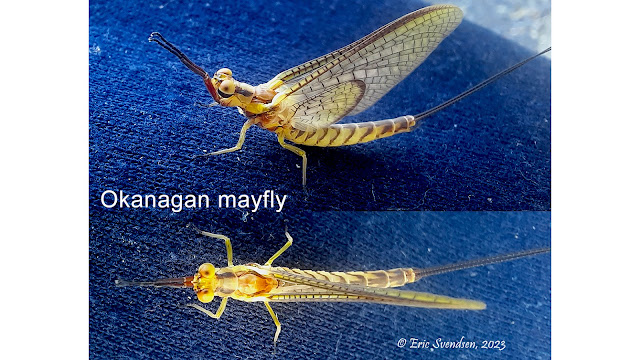Giant burrowing mayfly - Hexagenia limbata
Locally it is called the Okanagan mayfly, but it has a wide range and is more commonly called the giant burrowing mayfly. It can be found throughout North America and reaches its greatest population density around the Great Lakes.
Eggs are very small, one female lays an average of 4000 of them. The egg overwinters and hatches in the spring to produce a larva, called a naiad. The tiny larvae burrow in soft substrate and produce an open-ended tunnel where they live out their lives. The gills move back and forth creating a flow of water that brings both oxygen and organic material into the tube. The naiad feeds on organic material throughout its development. It may take up to two years for it to become an adult.
As adults, they undergo two moults, an unusual act for insects showing complete metamorphosis. The second moult takes place the day after the first moult; they become sexually mature at this stage. Adults have no functional mouthparts and live only for a couple of days. They may emerge throughout the year in warmer climates, but in cooler environments, they typically emerge synchronously. I read an interesting fact about them which I will include below. The link is here.
"Hexagenia limbata has been known to cause problems for people as a result of the large numbers of individuals that are involved in its synchronized emergences. In the northern half of their range where they are more abundant, this species can be detected on weather radar during the adult flights and is sometimes confused with storm activity (Figure 5). During flights and after they die, swarms can result in dangerous road conditions (car collisions have resulted), road closures, and a far-reaching smell of meter-deep decaying insect piles. Snow plows often have to be used to clear the piles of dead Hexagenia mayflies from roads."
Isn't that cool?
Thanks for reading.
Eric Svendsen www.ericspix.com




Comments
Post a Comment